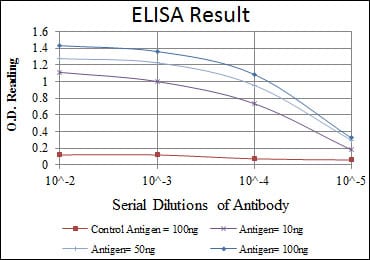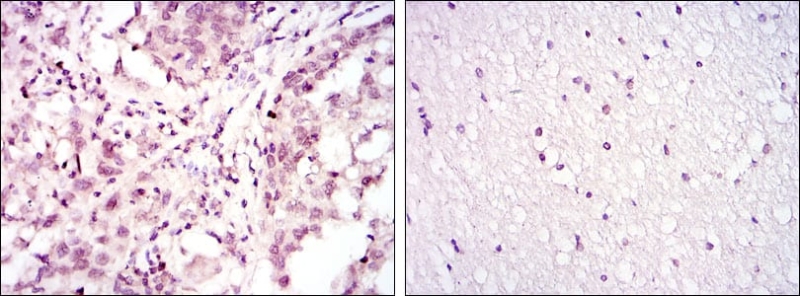


| WB | 1/500 - 1/2000 | Human,Mouse,Rat |
| IF | 咨询技术 | Human,Mouse,Rat |
| IHC | 1/200 - 1/1000 | Human,Mouse,Rat |
| ICC | 技术咨询 | Human,Mouse,Rat |
| FCM | 咨询技术 | Human,Mouse,Rat |
| Elisa | 1/10000 | Human,Mouse,Rat |
| Aliases | HB16; CREB2; TREB7; CRE-BP1; MGC111558; ATF2 |
| Entrez GeneID | 1386 |
| clone | 4F12 |
| WB Predicted band size | 55kDa |
| Host/Isotype | Mouse IgG1 |
| Antibody Type | Primary antibody |
| Storage | Store at 4°C short term. Aliquot and store at -20°C long term. Avoid freeze/thaw cycles. |
| Species Reactivity | Human,Mouse |
| Immunogen | Purified recombinant fragment of human ATF2 expressed in E. Coli. |
| Formulation | Ascitic fluid containing 0.03% sodium azide. |
+ +
以下是关于ATF2抗体的3篇参考文献及其摘要内容的简要概括:
---
1. **"ATF2 modulates the DNA damage response in melanoma cells"**
*Authors: Bhoumik A, et al. (2005)*
**摘要**:研究利用ATF2特异性抗体(Western blot和免疫组化)发现,ATF2的磷酸化状态影响黑色素瘤细胞对DNA损伤的响应,抑制ATF2活性可增强化疗敏感性。
2. **"Distinct roles of JNK and p38 kinases in the phosphorylation of ATF2 in response to stress"**
*Authors: Van Dam H, et al. (1993)*
**摘要**:通过免疫沉淀和激酶实验结合ATF2抗体,揭示JNK和p38激酶分别调控ATF2不同结构域的磷酸化,从而影响其转录活性及细胞应激反应。
3. **"ATF2 cooperates with Smad3 to mediate TGF-β-induced apoptosis in hepatocytes"**
*Authors: Lau E, et al. (2012)*
**摘要**:使用ATF2抗体(ChIP和免疫荧光)证明,TGF-β信号通过ATF2与Smad3的相互作用诱导肝细胞凋亡,提示ATF2在组织稳态中的关键调控作用。
---
**选择依据**:
- 覆盖癌症、信号通路、细胞凋亡等多元领域,体现ATF2抗体的广泛应用(WB、IP、ChIP等)。
- 文献时间跨度较长(1993-2012),反映不同阶段的研究重点。
- 摘要强调抗体在机制研究中的具体用途(如磷酸化分析、蛋白互作验证),贴合实验设计需求。
如需更多应用场景(如神经疾病),可补充特定领域文献。
The ATF2 (Activating Transcription Factor 2) antibody is a tool used to detect and study the ATF2 protein, a member of the basic leucine zipper (bZIP) family of transcription factors. ATF2 plays a dual role in cellular processes, acting as both a transcriptional activator and repressor. It is involved in stress responses, DNA damage repair, cell proliferation, and apoptosis. ATF2 binds to consensus cAMP-responsive elements (CRE) in DNA, often forming homodimers or heterodimers with other bZIP proteins like c-Jun, to regulate target gene expression. Its activity is modulated by post-translational modifications, particularly phosphorylation by stress-activated kinases (e.g., JNK, p38 MAPK), which enhance its transcriptional activity.
ATF2 antibodies are widely used in research to investigate its expression, localization, and activation status in various contexts, including cancer, neurodegeneration, and immune responses. For example, phosphorylated ATF2 (at Thr69/71) is a marker of its activated form, linking it to pathways like MAPK signaling. Dysregulation of ATF2 has been implicated in tumor progression, metastasis, and resistance to therapy, making it a potential biomarker or therapeutic target. These antibodies are validated for techniques like Western blotting, immunohistochemistry, immunofluorescence, and chromatin immunoprecipitation (ChIP). Researchers rely on their specificity to dissect ATF2's context-dependent roles, which can vary between pro-survival and pro-apoptotic functions depending on cellular conditions.
×